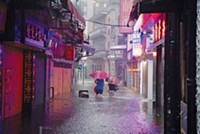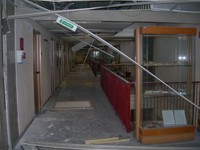Advertisement
Grab your lab coat. Let's get started
Welcome!
Welcome!
Create an account below to get 6 C&EN articles per month, receive newsletters and more - all free.
It seems this is your first time logging in online. Please enter the following information to continue.
As an ACS member you automatically get access to this site. All we need is few more details to create your reading experience.
Not you? Sign in with a different account.
Not you? Sign in with a different account.
ERROR 1
ERROR 1
ERROR 2
ERROR 2
ERROR 2
ERROR 2
ERROR 2
Password and Confirm password must match.
If you have an ACS member number, please enter it here so we can link this account to your membership. (optional)
ERROR 2
ACS values your privacy. By submitting your information, you are gaining access to C&EN and subscribing to our weekly newsletter. We use the information you provide to make your reading experience better, and we will never sell your data to third party members.
Business
Grace under Pressure as Rita Struck Texas
Site manager Gerald R. Ehrman geared up for the worst as he shut down DuPont's Sabine River Works
by Marc S. Reisch
November 21, 2005
| A version of this story appeared in
Volume 83, Issue 47

COVER STORY
Grace Under Pressure As Rita Struck Texas
In Thursday, Sept. 22, Gerald R. (Jerry) Ehrman, plant manager of the Sabine River Works in Orange, Texas, closed the plant down and locked the front gate. DuPont shares the site with Invista. Ehrman not only manages the site, but is also responsible for the DuPont assets—a resins manufacturing operation that covers 1,500 acres and employs about 1,600 people.
It was the first time in the 59 years since DuPont first developed the site that it was completely shut down.
As Hurricane Rita approached, Ehrman and a severe weather team evacuated to the town of Mauriceville, 15 miles to the north. The then-Category 5 storm was supposed to bring with it a 25-foot surge of water up the river. Mauriceville is on higher ground than Orange. Its elevation and two man-made barriers between Orange and Mauriceville—Interstate Highway 10 and elevated railroad tracks—would protect Mauriceville and the evacuees from the expected surge.
But in Orange, the Sabine River Works didnt have that kind of protection. And though it is located a little more than 25 miles from the Gulf Coast, it is only 8 feet above sea level. If the prediction for Hurricane Rita held out, a 17-foot wall of water would swamp the Sabine River Works. The water also would inundate neighboring plants, including those belonging to Chevron Phillips Chemical, Lanxess, and Firestone.
When Hurricane Katrina came through a month earlier, it didnt have much impact on us. We were 250 miles away, Ehrman says. The Sabine River Works had been spared only because Katrina took a turn toward New Orleans.
Ehrman loves Texas. I wasnt born here, but I got here as fast as I could, he says. A mechanical engineer by training, he has worked for DuPont for 41 years at various sites, including New York, West Virginia, Delaware, and Tennessee. He has seen severe weather in all parts of the country.
But this time was different. He was out of town early in the week as the storm approached, returning late Wednesday night, Sept. 21. At 12:30 on Thursday morning, he received a call from the countys top official—it was bad news.
Rita had switched directions again and now was heading for Sabine Pass on the Gulf Coast downriver from the Sabine River Works. Suddenly we went from being on the fringes of the storm to being in the direct line of the storm. The official told Ehrman that he was ordering a mandatory evacuation of the county.
Area residents left, including plant employees and their families. Many went to stay with friends and relatives in other parts of the country or drove to hotels that were expected to be outside of the storms path. Ehrmans family evacuated with him to Mauriceville.
The eye of the storm passed over the Sabine River Works during the early morning hours on Saturday, Sept. 24. By 9 AM, the storm had passed, but the winds were still between 30 and 50 miles per hour. But it was safe enough for the sheriff to escort members of the severe weather team, including those from other plants in the area, back to Chemical Row to assess the damage.
What Ehrman saw was disturbing. Though the storm surge never came, trees and power lines were down everywhere. As Ehrman and the group picked their way through a roadway littered with debris, they saw homes without roofs and uprooted trees resting on damaged homes. Ehrman would later find that a large oak tree had hit his own home, which also suffered roof damage and a collapsed chimney.
On the positive side, the DuPont plant had come through in good shape, with no flooding or environmental problems. The worst damage was to cooling towers that could be easily repaired. Some water had infiltrated buildings on-site, and carpeting in plant offices had to be ripped up to prevent mold. It would be two weeks before power could be restored to the plant along with other utilities and services, and then another 10 days before the plant could restart.
But in the aftermath of the storm, the greatest need was for food and shelter. Ehr-man got in touch with DuPont corporate leaders, and by the afternoon of Sunday, Sept. 25, they had sent in water, ice, tents, cots, generators, portable kitchens, tree-cutting crews, armed security guards, and staffs to cook for hungry work crews.
People are putting their lives back in order, and they are learning what is normal now.
Within a week, county officials were letting residents return to the area. Ehrman and his crew worked to get the plant up and running again. The firm set up a toll-free number and asked employees to call in so we could get them back to work when it was safe, Ehrman says.
Meanwhile, DuPont sent in 50 trailers to house the workers and their families whose homes were uninhabitable. The trailers filled as fast as we got them. Others stayed with relatives and friends. Some could move back home after they covered their roofs with tarps. The firm trucked in fuel for its own use and also dispensed it to the Coast Guard, police, and employees.
Today, 40 trailers still house displaced workers and their families on DuPonts site. Only 5% of homes in the area were undamaged, and getting a contractor to repair his own home has been difficult, Ehrman says. Still, he adds, people are putting their lives back in order, and they are learning what is normal now. There are a lot fewer trees. In some areas, 90% of the trees are gone. The power of the storm was awesome.




Join the conversation
Contact the reporter
Submit a Letter to the Editor for publication
Engage with us on Twitter